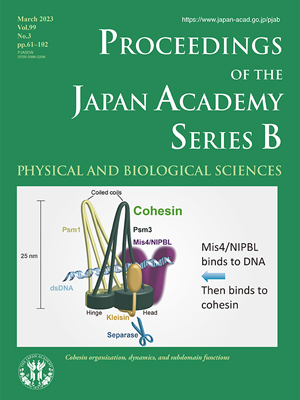About the Cover
Vol. 99 No. 3 (2023)
Cohesin is a heteropentameric protein complex that plays critical roles in sister chromatid cohesion, three-dimensional chromatin structure, DNA damage response, and gene expression. It contains two structural maintenance of chromosomes (SMC) subunits. The two SMC subunits (Psm1 and Psm3 in Schizosaccharomyces pombe) form a heterodimer characterized by a hinge dimerization domain, an ATPase head domain, and long coiled coils in between. The coiled coils of cohesin can fold around their midpoint. Kleisin and other non-SMC subunits associate with the SMC head domain. Cohesin is loaded onto chromatin by cohesin loader Mis4/NIPBL in the pre-replicative phase, and sister chromatin cohesion is established during S phase. In mitotic anaphase, a protease called separase is activated and cleaves Kleisin, releasing cohesin from chromatin. How cohesin acts to fulfill its functions remains elusive.
This illustration (modified from Xu X. et al. Proc. Natl. Acad. Sci. USA 115, E4833–E4842, 2018) depicts the cohesin complex described in the article (pp. 61–74) in the current issue, which summarizes a series of genetic suppressor screens performed to answer the above question. Mutational suppressors compensate for the growth lethality caused by a temperature-sensitive mutation affecting cohesion.Characterization of these mutations revealed novel insights into the cohesin complex. In particular, these studies demonstrated that the cleavage of cohesin by separase is dispensable when a mutation was introduced into the cohesin head or hinge domains. The ATPase heads of cohesin may regulate the dynamics of coiled coils. Modeling its tertiary structure indicates that these cohesin head/hinge mutations affect coiled coil orientation. Coiled coils may fold around their midpoints so that the head and hinge are proximal. Consequently, chromosomal DNA is held between the two folded coiled coils. The whole cohesin complex is thus ~25 nm in length, consistent with images taken using atomic force microscopy. Hence, suppressor analyses of temperature-sensitive mutants of cohesin and other genetic interactions supported the “hold-and-release” model, encouraging further biochemical and microscopic studies.
Shigekazu Nagata
Member of the Japan Academy




